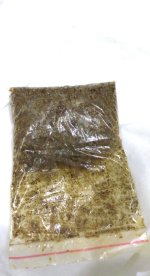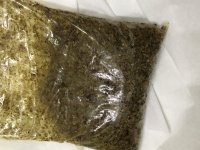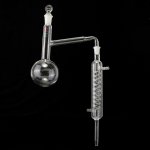Amphetamine synthesis from P2NP via Al/Hg (video)
- Thread starter HIGGS BOSSON
- Start date
My point was that in the HgNO3 amount is different in the video (where the powdered form is used) and the HgNO3 video where it is freshly prepared from Hg and Nitric acid. In the latter 5ml is used, which is about a quarter of the Hg from the thermometer, so way more than the 0.1g pure mercury nitrate (which contains 0.062g of elemental mercury). I don`t know why this difference.
Louis Pasteur
Newbie
Hello.
I have a problem with this reaction. I tried performing it twice. I am using lab grade reagents and lab glassware. I scaled down the reagents proportionally, because I use a 1l flask. The issue appears when i try to reduce the P2NP using aluminium amalgam.
I prepare the solution of P2NP, heating it just enought to dissolve the crystals.
I use a coffee grinder to grind the aluminium into little globs - as written in the Aluminium amalgam (Al/Hg) summary.
After adding HgCl2, I pour in 0,5l of cold distilled water. 10 minutes later the reaction begins.
The first time I waited until no more small bubbles were forming and all of the aluminium was floating, the water - cloudy gray. I rinsed it twice with little cold distilled water, drained thoroughly. I added the P2NP solution, no reaction took place. I noticed the P2NP partly crystallized. I tried starting the reaction with heat, but to no avail.
The second time I drained the water from the amalgam when lots of small bubbles appeared and most of the aluminium had surfaced, the water was cloudy gray. Once again - I rinsed it twice with little cold distilled water, drained thoroughly. After the addition of P2NP the result was identical as the first attempt. Heating the mixture did not help.
What am I doing wrong? What should I change? Do you have any suggestions?
Any help will be greatly appreciated
I have a problem with this reaction. I tried performing it twice. I am using lab grade reagents and lab glassware. I scaled down the reagents proportionally, because I use a 1l flask. The issue appears when i try to reduce the P2NP using aluminium amalgam.
I prepare the solution of P2NP, heating it just enought to dissolve the crystals.
I use a coffee grinder to grind the aluminium into little globs - as written in the Aluminium amalgam (Al/Hg) summary.
After adding HgCl2, I pour in 0,5l of cold distilled water. 10 minutes later the reaction begins.
The first time I waited until no more small bubbles were forming and all of the aluminium was floating, the water - cloudy gray. I rinsed it twice with little cold distilled water, drained thoroughly. I added the P2NP solution, no reaction took place. I noticed the P2NP partly crystallized. I tried starting the reaction with heat, but to no avail.
The second time I drained the water from the amalgam when lots of small bubbles appeared and most of the aluminium had surfaced, the water was cloudy gray. Once again - I rinsed it twice with little cold distilled water, drained thoroughly. After the addition of P2NP the result was identical as the first attempt. Heating the mixture did not help.
What am I doing wrong? What should I change? Do you have any suggestions?
Any help will be greatly appreciated
Hi,
I`ve got the same problem, except that I have tried at least 6 times. No reaction. If I let it run as long as there is any activity then the Al turns blackish colour and it is greatly reduced in volume, after adding the P2NP/GAC/IPA it `freezes` with some yellow-white precipitate. Warming, even near boiling does not help. If I run the Amalgam until everything floats and most of the bubbling subsides, I get no reaction at all. Now I have a lot of P2NP to recrystallize. Perhaps we are using the wrong foil?
I`ve got the same problem, except that I have tried at least 6 times. No reaction. If I let it run as long as there is any activity then the Al turns blackish colour and it is greatly reduced in volume, after adding the P2NP/GAC/IPA it `freezes` with some yellow-white precipitate. Warming, even near boiling does not help. If I run the Amalgam until everything floats and most of the bubbling subsides, I get no reaction at all. Now I have a lot of P2NP to recrystallize. Perhaps we are using the wrong foil?
Louis Pasteur
Newbie
If you take too much time to rinse the amalgam and it has completely reacted out, the impetus for the reaction may simply be missing. The change should be made relatively quickly. In the beginning, I omitted rinsing with water and managed to get a reaction every time. Theoretically, you can add the P2NP solution to the aluminum foil and then the mercury salt, completely without using water first. This reaction always succeeds, but should be used very carefully with larger quantities, because the reaction can no longer be cooled to control it. Also, the yields are purely a matter of luck. Here no proper amalgam is formed for reduction, actually one builds so a toxic, corrosive and hot volcano. But rather one warns the people before they themselves go completely clueless to the matter.
Louis Pasteur
Newbie
Hello.
I performed the reaction on a smaller scale - 1g of P2NP.
When the aluminium started to break down into smaller pieces(due to stirring), I drained it, then proceeded to add 2ml of cold distilled water. The solution of P2NP was added. Reaction began instantly. No further problems were encountered. The final product came out looking great.
I performed the reaction on a smaller scale - 1g of P2NP.
When the aluminium started to break down into smaller pieces(due to stirring), I drained it, then proceeded to add 2ml of cold distilled water. The solution of P2NP was added. Reaction began instantly. No further problems were encountered. The final product came out looking great.
Thats sounds good, its just a matter of timing, you will never get the perfect amalgam or achieve the perfect implementation of P2NP. You can also heat the P2NP solution to 50°C so that the crystals do not precipitate so quickly (this prevents reduction with the amalgam), also a small amount of mercury salt should be able to indirectly restart the reaction if there is still aluminum left in the solution.
Otherwise, practice and practice again, until you know how to do it, it is not really difficult.
Otherwise, practice and practice again, until you know how to do it, it is not really difficult.
P2NP tends to decompose under the influence of light, heat and oxygen. It becomes brown/reddish. The best storage is at approx. 5°C dark and well closed in a container. Here there is only the possibility of recrystallization with considerable loss of P2NP.
In a very small scale it would be possible yes.
I think 5g P2NP and 6g Alu foil, 50ml IPA and 25 ml glacial acetic acid are to much for a 250ml Flask, try 500-1000ml, or with a smaller 1g P2NP scale.
In a very small scale it would be possible yes.
I think 5g P2NP and 6g Alu foil, 50ml IPA and 25 ml glacial acetic acid are to much for a 250ml Flask, try 500-1000ml, or with a smaller 1g P2NP scale.
1) Make sure that you use aluminum foil with no other elements in it.
2) Test how your foil reacts with the mercury until it completely disappears. Visually evaluate the steps of the amalgamation reaction and remember at which point to wash with water.
3) Perform one reduction reaction without washing the foil and record the results for comparison.
4) Too small pieces of foil promote very violent reaction of Al+H2O and you may not have time to carry out the P2PN reduction reaction. So try to increase the size of the foil pieces.
5) If you have washed the foil for too long, the aluminum may have deactivated and become covered by the oxide film again. In this case, you need to add a portion of mercury nitrate and perform the amalgamation again. Some chemists, seeing that the reduction reaction has stopped and most of the foil remains unreacted, add a pinch of mercury nitrate to the flask with all the reagents loaded, including the P2NP solution, and thus the amalgamation reaction goes directly with the reduction reaction.
2) Test how your foil reacts with the mercury until it completely disappears. Visually evaluate the steps of the amalgamation reaction and remember at which point to wash with water.
3) Perform one reduction reaction without washing the foil and record the results for comparison.
4) Too small pieces of foil promote very violent reaction of Al+H2O and you may not have time to carry out the P2PN reduction reaction. So try to increase the size of the foil pieces.
5) If you have washed the foil for too long, the aluminum may have deactivated and become covered by the oxide film again. In this case, you need to add a portion of mercury nitrate and perform the amalgamation again. Some chemists, seeing that the reduction reaction has stopped and most of the foil remains unreacted, add a pinch of mercury nitrate to the flask with all the reagents loaded, including the P2NP solution, and thus the amalgamation reaction goes directly with the reduction reaction.
Last edited by a moderator:
About Us
Our team brings together the best specialists from different fields.
We are ready to share our experience, discuss difficult issues and find new solutions.



